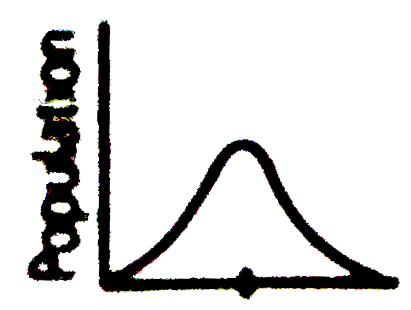If a trait exists in 10% of population of an asexually reproducing species and a triat B exist in 60% of the same population, which trait is likely to have arisen earlier?
To determine which trait is likely to have arisen earlier in a population of an asexually reproducing species, we can analyze the prevalence of each trait in the population.
1. Understanding Trait Prevalence:
- Trait A exists in 10% of the population.
- Trait B exists in 60% of the population.
2. Asexual Reproduction:
- In asexually reproducing species, traits are passed down directly from one generation to the next without the mixing of genetic material from two parents. This means that once a trait appears, it can quickly spread through the population if it is advantageous.
3. Analyzing the Percentages:
- Since Trait B is present in 60% of the population, it indicates that a significant number of individuals possess this trait.
- Conversely, Trait A, which is present in only 10% of the population, suggests that it is much less common.
4. Inferring the Likelihood of Origin:
- A trait that is more prevalent in the population (like Trait B) is likely to have arisen earlier because it has had more time to spread and be passed down through generations.
- Trait A, being present in only 10% of the population, suggests that it is a newer or less successful trait that has not spread as widely.
5. Conclusion:
- Based on the prevalence of the traits, it is reasonable to conclude that Trait B is likely to have arisen earlier than Trait A.
Final Answer:
Trait B is likely to have arisen earlier.
---
- Trait A exists in 10% of the population.
- Trait B exists in 60% of the population.
- In asexually reproducing species, traits are passed down directly from one generation to the next without the mixing of genetic material from two parents. This means that once a trait appears, it can quickly spread through the population if it is advantageous.
- Since Trait B is present in 60% of the population, it indicates that a significant number of individuals possess this trait.
- Conversely, Trait A, which is present in only 10% of the population, suggests that it is much less common.
- A trait that is more prevalent in the population (like Trait B) is likely to have arisen earlier because it has had more time to spread and be passed down through generations.
- Trait A, being present in only 10% of the population, suggests that it is a newer or less successful trait that has not spread as widely.
- Based on the prevalence of the traits, it is reasonable to conclude that Trait B is likely to have arisen earlier than Trait A.
Trait B is likely to have arisen earlier.
Topper's Solved these Questions
- HEREDITY AND EVOLUTIONBook:MBD -HARYANA BOARDChapter:HEREDITY AND EVOLUTIONExercise:Long Answer Type Questions
Explore 2 Videos
- CONTROL AND COORDINATIONBook:MBD -HARYANA BOARDChapter:CONTROL AND COORDINATIONExercise:EXAMPLE
Explore 150 Videos
- HOW DO ORGANISMS REPRODUCE?Book:MBD -HARYANA BOARDChapter:HOW DO ORGANISMS REPRODUCE?Exercise:EXAMPLE
Explore 185 Videos
Similar Questions
If a trait A exists in 10% of a population of an asexually reproducing species and a trait B exists in 60% of the same population, which trait is likely to have arisen earlier?
View SolutionIf a trait A exists in 10% of a population of an asexually reproducing species and a trait B exists in 60% of the same population, which trait is likely to have arisen earlier?
View Solution
Knowledge Check
Assertion Polymorphism is the existence of two or more forms of the same species within the same population
Balanced polymorphism occurs when different forms coexist in the same population in a stable environmentABoth Assertion and Reason are true, but Reason is the correct explanation of AssertionBBoth Assertion and Reason are true, but Reason is not the correct explanation of AssertionCAssertion is true, but Reason is falseDAssertion is false, but reason is trueIn a city, 40% of the people are illiterate and 60% are poor. Among the rich 10% are illiterate. The % of the illiterate poor population is ?
A46%B44%C38%D36%10% of Brazil's population migrated to South Affrica 10% of the remaining migrated to America and 10% of rest migrated to Australia. If the female population which was left in Brazil remained only 3,64,500 , Find the population of Brazil city before the migration the female population was half the male population and this ratio did not change after the migration ?
A1800000B1500000C1600000D1400000
If a trait A exists in 10% of a population of an asexually reproducing species and a trait B exists in 60% of the same population, which trait is likely to have arisen earlier?
View SolutionIf a trait A exists in 10% of a population of an asexually reproducing species and a trait B exists in 60% of the same population, which trait is likely to have arisen earlier.
View SolutionIn 2019 if there is 10% increase in population of city A and 15% decrease in the population in B as compared to that in 2018 ,then the population of city A is what percentage more /less than in B , in that year ? (correct to one decimal places)

View SolutionThe following graph shows the range of variation among population members for a trait determined by multiple genes.

If this population is subject to stabilizing selection for several generations, which of the distribution is most likely to result ?
View SolutionThe given graph shows the range of variation among population members for a trait determined by multiple genes. If this population is subjected to disruptive selection for several generations, which of the following distributions is most likely to result?

View Solution
